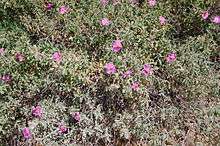''Cistus'' × ''incanus''
| Cistus × incanus | |
|---|---|
 | |
| Scientific classification | |
| Kingdom: | Plantae |
| Clade: | Angiosperms |
| Clade: | Eudicots |
| Clade: | Rosids |
| Order: | Malvales |
| Family: | Cistaceae |
| Genus: | Cistus |
| Species: | C. × incanus |
| Binomial name | |
| Cistus × incanus L.[1] | |
| Synonyms | |
|
See § Taxonomy. | |
Cistus × incanus L. is a hybrid between Cistus albidus and Cistus crispus.[2] The name "Cistus incanus" (synonym C. villosus) has been used by other authors in a different sense, for Cistus creticus (at least in part). The English name hoary rock-rose may be used to refer to this species,[3] among others.
Description
Because of confusion between the original species named by Linnaeus in 1753 and the way in which the name was used by later authors (see § Taxonomy), plants described under this name may actually belong to different species. C. × incanus is a shrubby plant, to about 1 m (3 ft) tall, with grey-green leaves and pink to purple flowers.
Taxonomy
The name Cistus incanus was first used by Carl Linnaeus in 1753 in Species Plantarum.[1][4] Confusion exists among this name and two later names published by Linnaeus, Cistus creticus in 1762 and Cistus villosus in 1764. There is general agreement that C. villosus, at least as used by later authors, is not a distinct species. Two treatments are then found.
In the first, generally older, treatment, C. incanus is accepted, with C. villosus a synonym.[5] C. creticus is treated as C. incanus subsp. creticus.[6]
According to Demoly (1996), Linnaeus's Cistus incanus was recognized to be a hybrid as early as 1904.[7] The second treatment (followed here) is based on this recognition. C. creticus is accepted, with C. villosus as a synonym.[8] C. × incanus L. is treated as the hybrid C. albidus × C. crispus.[2] As used by previous authors, but not Linnaeus, the name "C. incanus" is taken to refer to Cistus creticus, particularly C. creticus subsp. eriocephalus.[9] Two formerly recognised subspecies of C. incanus are regarded as subspecies of Cistus creticus:
- Cistus × incanus subsp. corsicus = C. creticus subsp. corsicus[10]
- Cistus × incanus subsp. creticus = C. creticus subsp. creticus
References
- 1 2 "Cistus × incanus", The Plant List, retrieved 2015-02-28
- 1 2 Guzmán, B. & Vargas, P. (2005), "Systematics, character evolution, and biogeography of Cistus L. (Cistaceae) based on ITS, trnL-trnF, and matK sequences", Molecular Phylogenetics and Evolution, 37: 644–660, PMID 16055353, doi:10.1016/j.ympev.2005.04.026, p. 646
- ↑ BSBI List 2007, Botanical Society of Britain and Ireland, archived from the original (xls) on 2015-01-25, retrieved 2014-10-17
- ↑ Carl Linnaeus (1753), "Cistus", Species Plantarum, vol. 1, pp. 523–524
- ↑ "Cistus incanus L.", Integrated Taxonomic Information System on-line database, retrieved 2015-03-01
- ↑ "Cistus creticus L.", Integrated Taxonomic Information System on-line database, retrieved 2015-03-01
- ↑ Demoly, Jean-Pierre (1996), "Les hybrides binaires rares du genre Cistus L. (Cistaceae)", Anales del Jardín Botánico de Madrid (in French), 54 (1): 242–254, retrieved 2015-03-01
- ↑ "Cistus creticus", The Plant List, retrieved 2015-03-01
- ↑ "Cistus creticus subsp. eriocephalus", The Plant List, retrieved 2015-03-01
- ↑ "Cistus creticus subsp. corsicus", The Plant List, retrieved 2015-03-01
| Wikimedia Commons has media related to Cistus × incanus. |